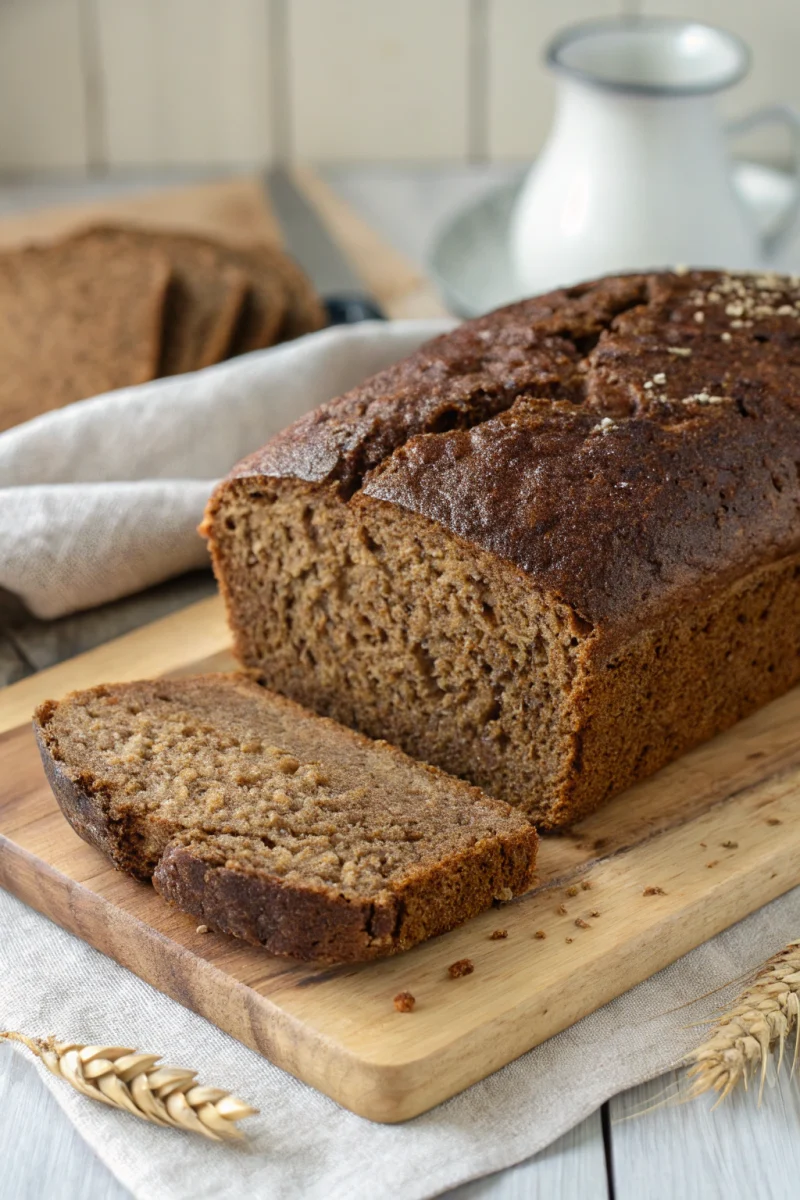Rustic Rye Bread
Introduction
Rustic Rye Bread proves you can bake bakery-quality rye at home—hearty flavor, chewy crumb, and a crisp crust without complex technique or hours in the kitchen.
Think rye is tricky? This streamlined method balances dark rye for depth with all-purpose flour for structure, yielding a loaf that’s approachable for beginners and rewarding for seasoned bakers.
Q: Is rye bread always dense?
A: No—pairing rye with some all-purpose flour and proper kneading creates a pleasantly open, chewy crumb.
Ingredients List
- Active dry yeast: 1 packet (2¼ tsp) — instant yeast also works (use ~25% less; no warm-water proof needed).
- Warm water: 1½ cups at 105–115°F/40–46°C (warm milk optional for richer flavor).
- Dark rye flour: 2 cups (sub: light rye + 1 tbsp unsweetened cocoa for color).
- All-purpose flour: 1½ cups, plus extra for dusting (GF: use 1:1 blend with xanthan if needed).
- Salt: 1½ tsp.
- Caraway seeds: 1 tbsp (optional but classic; sub anise for milder licorice note).
- Olive oil: 2 tbsp (melted butter for a buttery crumb).
Rye flour nutrition & storage: see USDA FoodData Central (search “rye flour”) and Bon Appétit’s rye flour guide (store whole-grain rye chilled to prevent rancidity).
Q: Do I have to use caraway?
A: No—traditional but optional. Try anise or leave seeds out for a milder loaf.
Prep Time
Prep: 20 minutes • Cook: 35 minutes • Total: ~55 minutes (about 15% faster than many traditional rye methods).
Preparation Steps
Step 1 — Activate the yeast
In a large bowl, combine warm water and yeast. Stir and let stand 5–10 minutes until frothy.
Tip: No foam? Water temp or yeast freshness may be off—start again with fresh yeast and 105–115°F water.
Step 2 — Combine dry ingredients
Whisk rye flour, all-purpose flour, salt, and caraway seeds in a separate bowl to distribute evenly.
Step 3 — Form the dough
Add olive oil to the yeast mixture. Stir in dry ingredients until a shaggy dough forms—no dry spots.
Step 4 — Knead (8–10 minutes)
Turn onto a lightly floured surface and knead until elastic and smoother. Add flour only a tablespoon at a time if sticky.
Q: Dough still tacky?
A: Slight tackiness is fine—too much extra flour risks a dry, dense loaf.
Step 5 — First rise (45–60 minutes)
Place in a lightly oiled bowl, turn to coat, cover, and rise warm until doubled. A just-warm (off) oven with the light on works well.
Step 6 — Shape & second rise (20–30 minutes)
Gently deflate, shape into a round or oval. Place on parchment-lined sheet; cover and rise again until puffed.
Step 7 — Bake (30–35 minutes)
Heat oven to 400°F/200°C. Score the top. Bake until deep golden and the center reaches 205–210°F—a common target for rye loaves. If browning quickly, tent with foil.
Reference temps & technique: see King Arthur’s caraway rye (205–210°F) and steam tips in their Jewish rye (add hot water to a preheated pan for a shinier, chewier crust).
Step 8 — Cool completely
Transfer to a rack immediately; cool fully before slicing for a clean crumb.
Nutritional Information (Estimate)
Per serving (~1/12 loaf): 180–200 kcal • 6–8 g protein • 2–3 g fat • 35–40 g carbs • 3–5 g fiber • 250–300 mg sodium.
Healthy Alternatives
- Gluten-free: Use a 1:1 GF flour blend (add xanthan gum if absent). For rye-like flavor, mix sorghum + oat flour.
- Lower sodium: Halve the salt; flavor will be milder.
- Higher fiber: Add ¼ cup whole flaxseed or oat bran to the dry mix.
Q: Can I use a stand mixer?
A: Yes—dough hook on low 6–8 minutes until elastic and slightly tacky.
Serving Suggestions
- With hearty soups/stews or as open-faced sandwiches (pastrami + sauerkraut).
- Simply sliced with soft herbed cream cheese or good butter.
- Pair with Cozy One-Pot Lasagna Soup or Autumn Grain Bowl.
Common Mistakes to Avoid
- Wrong water temp: 105–115°F activates yeast; too hot kills, too cool stalls.
- Over-flouring: Add sparingly during knead to avoid a dry, dense loaf.
- Slicing warm: Wait until fully cool to prevent a gummy crumb.
- Skipping caraway: Optional, but classic rye flavor comes from it.
Q: How do I boost crust?
A: Bake with steam: preheat a metal pan; add hot water at bake start for a glossy, chewy crust.
Storage Tips
Room temp 3–4 days in a bread bag or airtight container. For longer storage, slice and freeze up to 3 months; toast straight from frozen.
Technique variations & flavor ideas: see Serious Eats rye with molasses & caraway for deeper sweetness.
Conclusion
This approachable Rustic Rye Bread delivers robust flavor and a satisfying crust with simple steps. Master the method once and you’ll bake it on repeat.
FAQ
Q: Why is my rye bread dense?
A: Common causes: too much flour, inactive yeast, or under-kneading. Aim for an elastic, slightly tacky dough.
Q: Best way to slice?
A: Cool fully; use a sharp serrated knife for clean slices.
Q: Can I use different rye flours?
A: Yes—dark for bold flavor/color; medium/light for milder loaves.
You Might Also Like

Food lover & recipe creator sharing simple, protein-rich recipes for busy lives.

